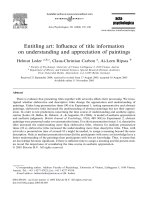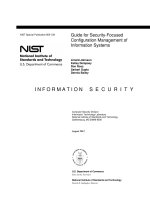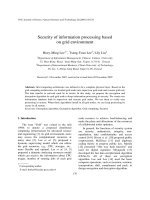Lecture On safety and security of information systems: Symmetric ciphers
Bạn đang xem bản rút gọn của tài liệu. Xem và tải ngay bản đầy đủ của tài liệu tại đây (872.21 KB, 41 trang )
SYMMETRIC CIPHERS
Contents
1)
Block Cipher Principles
2)
Feistel Cipher
3)
Data Encryption Standard (DEC)
CRYPTOLOGY
CRYPTOGRAPHY
SYMMETRIC
CLASSICAL
MODERN
Substitution
Block ciphers
Transposition
Stream ciphers
ASYMMETRIC
CRYPTANALYSIS
1. Block Cipher Principles
Stream Ciphers and Block Ciphers
A stream cipher is a type pf symmetric encryption in which input data is
encrypted one bit (byte) at a time.
Stream Ciphers and Block Ciphers
Block Ciphers is one in which the plaintext is divided in blocks and one
block is encrypted at a time producing a ciphertext of equal length
Block size?
2. Feistel Cipher
The Feistel Cipher
Horst Feistel devised the feistel cipher
Most symmetric block ciphers are based on a feistel cipher structure.
Feistel proposed the use of a cipher that alternates substitutions and
permutations, where these terms are defined as follows:
Substitution: Each plaintext element or group of elements is uniquely replaced
by a corresponding ciphertext element or group of elements
Permutation: A sequence of plaintext elements is replaced by a permutation of
that sequence
Feistel Cipher Structure
The Plaintext block: 2w bits
The plaintext block is divided into two halves,
L0 and R0.
L, R pass through n rounds of processing and
then combine to produce the ciphertext block.
Each round i (1->16):
Feistel Cipher Principles
The exact realization of a Feistel network depends on the choice of the
following parameters and design features:
Block size: Larger block sizes mean greater security but reduced
encryption/decryption speed for a given algorithm.
Key size: Larger key size means greater security but may decrease
encryption/decryption speed.
Number of rounds: increase number improves security, but slows cipher
Feistel Cipher Principles (cont.)
Subkey generation algorithm: Greater complexity in this algorithm
should lead to greater difficulty of cryptanalysis.
Round function F: greater complexity generally means greater resistance
to cryptanalysis.
Feistel decryption algorithm
Feistel decryption algorithm
Consider the encryption process
On the decryption side
Feistel decryption algorithm
The XOR has the following properties:
Thus, we have:
Feistel Example
3. Data Encryption Standard - DEC
Data Encryption Standard - DEC
The Data Encryption Standard (DES) is a symmetric-key block cipher
published by the National Institute of Standards and Technology (NIST).
A block cipher
Data Encrypted in 64-bits blocks using a 56-bit key; ciphertext is of 64-bit
long.
Number of rounds: 16
Description
The 64-bit plaintext passes through an initial permutation (IP) that rearranges the
bits to produce the permuted input.
Sixteen rounds of the same function, which involves both permutation and
substitution functions. The output of the last (sixteenth) round consists of 64 bits
that are a function of the input plaintext and the key. The left and right halves of
the output are swapped to produce the preoutput.
Finally, the preoutput is passed through the inverse of the initial permutation
function, to produce the 64-bit ciphertext
Initial Permutation (IP)
The ouput bit-1 for example is the input bit 58
Find the output of the initial permutation box when the input is given in
hexadecimal as: 0x0002 0000 0000 0001
Inverse Initial Permutation (IP-1)
Find the output of the inverse initial permutation box when the input is given in
hexadecimal as: 0x0000 0080 0000 0002
Details Of single round
The left and right halves of each 64-bit
intermediate
value
are
treated
as
separate 32-bit quantities, labeled L
(left) and R (right)
E table
Expansion Permutation: 32bit → 48 bit
Details Of single round (cont.)
After the expansion permutation, DES uses the XOR operation on the
expanded right section and the round key
S-Boxes
Input: 6-bit
Output: 4-bit
The 48-bit data from the second operation is divided into eight 6-bit chunks,
and each chunk is fed into a box. The result of each box is a 4-bit chunk









